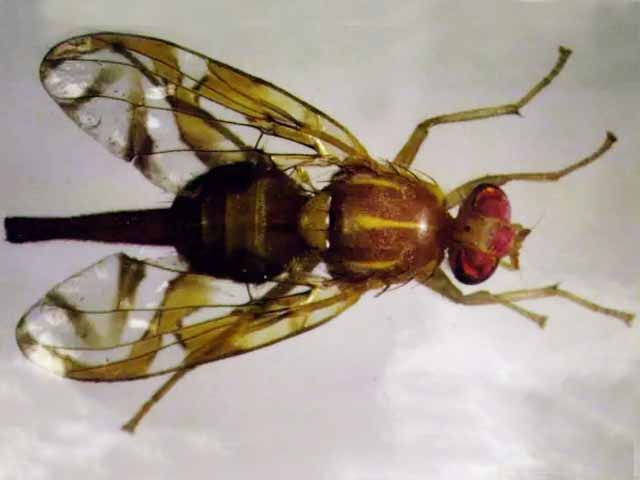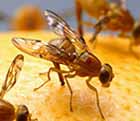Mexican Fruit Fly
Pest Profile


The adult Mexican fruit fly is larger than a housefly, about 1.0 cm (0.38 inch) long. The body color is a pale orange-yellow with two to three whitish stripes along the thorax. The wings are clear except for several yellow and brown stripes. The female is distinguished by a long and slender ovipositor which is used to deposit eggs beneath the skin of the host fruit. The maggots (larvae) are legless, and range in color from white to yellowish-white, and grow to a length of 1.0 cm within the host fruit.
History and Economic Importance
The Mexican fruit fly was first described in 1863 Central Mexico. In 1927, the Mexican fruit fly was first discovered infesting the Rio Grande Valley of Texas, and by the early 1950s, flies were found along the California-Mexico border. The Mexican fruit fly is an important agricultural pest in Mexico and parts of Central America where it readily attacks citrus, mango, avocado and a wide variety of other fruits. A large number of commercially grown crops in California would be threatened by the introduction of this pest, including peach, avocado, orange, grapefruit and pear. Mexican fruit fly adults have been trapped a number of times in California and several infestations have been eradicated from the state.
Distribution
The Mexican fruit fly is found in Belize, Costa Rica, El Salvador, Guatemala, Honduras, Mexico and Nicaragua. The pest is occasionally present in some areas of Texas. Incursions are eradicated.
Life Cycle
Eggs are laid singly or in groups of up to 18, and a female may lay several thousand eggs in her lifetime. Larvae go through three instars and may require from 11 days to over a month to complete development, depending on temperature. At maturity, the larvae exit the fruit and burrow into the soil to pupate. Adults emerge from 12 to 100 days later depending on temperature. Newly-emerged adults usually require from eight to 34 days to mature prior to egg laying. Breeding is continuous with four to six generations a year under optimum conditions.
Host and Damage
Fruit that has been attacked may be unfit to eat. Larvae feed while tunneling through the interior of infested fruits. Microscopic organisms invade these injured areas causing internal decay of the fleshy portions of the fruit. Over 50 host plants have been recorded as being attacked by the Mexican fruit fly.
